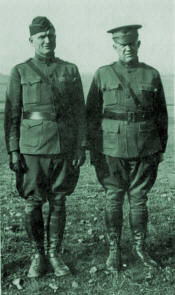The Story of the American Expeditionary Forces |
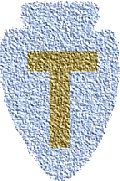
|
FORGOTTEN VICTORY
|

Atop Blanc Mont Today
A Monument to the US Effort of 1918 Stands Guard

To find other features on the DOUGHBOY CENTER visit our
General Headquarters
For further information on the events of 1914-1918
visit the homepage of
The Great War Society
Phase II Operations
October 7th - 8thThe new German position, located at the end of the northern slope and in front of the Second, extended roughly from St. Etienne eastward-southeastward…The fortifications hardly compared to those along the old Hindenburg Line, but they were formidable enough. The St. Etienne cemetery and the surrounding countryside were well fortified. "Cunningly situated machine gun nests were connected by tunnels with the cemetery and with each other, and the ravine through which the Ames brook flowed was utilized to conceal the movement of troops to and from the cemetery." The French and Americans had been in and out of St. Etienne in the recent action. The area immediately behind the entire defense system had for years been the base for the troops occupying the Hindenburg Line.…Because the French considered the "immediate presence" of a reserve brigade in the Somme-Py sector as imperative owing to heavy casualties incurred by the 4th Marine Brigade, Maj. Gen. William R. Smith, Commander of the Thirty-Sixth Division was instructed by send one brigade and the Field Signal Battalion by French camions (trucks) to the Suippes-Somme-Py area… Smith selected the 71st Brigade to make the movement because it could be picked up quicker than the 72nd…...Lejeune conferred with Whitworth, Bloor, and Jackson at his PC, now in a German dugout north of Souain on the Suippes-Somme-Py road. The 71st, Lejeune announced, would relieve the 3rd and 4th Brigades of the Second Division in the line on the night of October 6……The 142nd Infantry was to relieve the 4th Marine Brigade (Brigadier General Wendell C. Neville) on the left and the 141st was to relieve the 3rd Brigade (Brigadier General Hanson E. Ely) on the right. Several Second Division battalions were to be at Whitworth's disposal for a short time after the 71st arrived at the front. 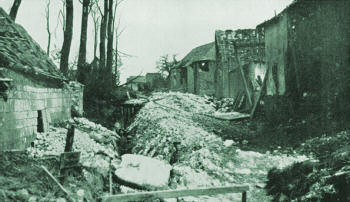 Fortified Structures at St. EtienneDuring the day the brigade trains (not to be confused with the separate trains of the Thirty-Sixth Division) however inadequate came up and the 37mm guns and mortars of the 142nd Infantry were trucked in. The German artillery fire emanated from the hills north and northeast of St. Etienne. Although visibility was only fair due to fog and occasional drizzle, German planes were out in some force dropping bombs, strafing, collecting data, and spotting for the artillery. A few French planes were seen, but they were less than aggressive. The "superiority of the air," Washam declared, "was all on Jerry's side" in the Champagne. Enemy dominance of the air and the efficiency of his aerial observers in planes and balloons were key factors in the effectiveness of his artillery. German planes would no sooner spot a target than German 155s, nicknamed "G. I. Cans," and Austrian 88s, known as "whizbangs," would begin raining on it. On the Phase I Map The German and American lines, which on October 7-8 extended about two and one-half miles along the St. Etienne-Orfeuil road, with the Texans and Oklahomans on the south side except at the far left, were in places little more than 100 yards apart. The numerous growths of pines on the northern slope of Blanc Mont gradually dwindled to scattered woods and brush about St. Etienne. The German entrenchments were on ground slightly higher than that of the Americans. Machine gun nests were concealed in wooded spots and arranged "in depth" so that "when one was captured" the captors would come under the enfilade fire of another. Belts of barbed wire were strung in the woods and open spaces in easy range of the machine guns. The Ames rivulet flowed from northeast to southwest, touching St. Etienne on its south bank. Several small hills, observation posts, and deep dugouts further punctuated the landscape. …The American line from left to right consisted of one battalion of the 4th marine Brigade, the 142nd Infantry, the 141st Infantry, and one battalion of the 3rd Brigade supported by at least one machine gun company. The 132nd Machine Gun Battalion was divided between the 142nd and 141st Infantries. The French 7th Division was on the left and the French 73rd Division was on the right. There were several gaps in the line, of which the most conspicuous was that between the 142nd and the 141st Infantries. The gaps, which made lateral communication difficult, were inherited from the Second Division. Whatever the disparity in numbers, the Germans enjoyed the advantage of fighting defensively from fixed positions. Fighting on the offensive meant that the Americans in carrying the fight would be exposed to German firepower, notably artillery and machine guns… The Germans were lacking in some supplies, such as gasoline for their motor vehicles, but they were not short on arms and ammunition. While the 71st Brigade was digging in on the morning of October 7, [French Corps Commander] Naulin was informing Lejeune at the latter's dugout "that a general attack would take place at daylight on the 8th, and that he anticipated that the fresh brigade would achieve a success equal to that gained by the Second Division on October 3rd." Lejeune protested that Naulin "was expecting the impossible of untried troops" and urged that they be allowed "a few days' training under fire" before using them in an all-out attack. Naulin was unmoved, however…
…The Americans might as well have transmitted orders by telephone because the Germans…concluded the day before, upon observing the "strong traffic along the enemy rear lines of communication moving chiefly in the direction of St. Etienne, and apparently also a number of tanks," that "a major hostile attack" was planned for October 8. Hence their forward units were alerted and their reserves placed "in readiness" well before the zero hour. At almost the same moment as the Americans 75s and 155s opened up, the German artillery commenced a "literally appalling" counterbarrage. Many bursts emitted clouds of toxic gas. The vast majority of shells fell behind the assault battalions and inflicted "severe losses" on the support and reserve battalions. German planes and about six observation balloons directed artillery fire practically without molestation. Occasionally the planes swooped down for strafing runs on the infantry. The placement of the German artillery was consistently good while that of the Americans was poor throughout the day. The rolling barrage laid down by the 2nd Field Artillery fell beyond rather than on top of the German entrenchments. Virtually untouched by the shelling, the German gunners greeted the assault battalions with flaming sheets of excruciating machine gun fire. Casualties were heavy as the troops worked their way through the mass of wire entanglements. The Germans fought well at long range, but, no doubt owing to a lack of enthusiasm borne of war-weariness, usually had no stomach for fighting at close quarters. "Kamerad," or its English translation, "comrade," the words the Germans used to indicate surrender, became familiar cries as the Indians, Mexicans, and Caucasians enveloped one machine gun emplacement after another. Taking the machine guns involved considerable casualties and some angry and excited soldiers, who survived their deadly fire and closed on them, evidently shot a number of gunners when they emerged to surrender. Captain Richard F. Burges of El Paso, Company A, 141st Infantry, in describing the October 8 action to a friend, stated that the Germans "fight under cover, firing from concealed machine guns until you close with them, then they rush out, throw up their hands, and cry 'comrade' but it doesn't look fair and they don't get much mercy." Burges "saved" the prisoners, several of whom were boys, "almost children," when "the capture was made under my own eyes." The confusion that accompanied the attack worsened as the fighting progressed. Many officers were killed, wounded, or gassed shortly after going over the top and the men in the support and reserve battalions were, according to Lejeune and others, so eager to get into the fight that they closed up on the assault battalions. Liaison between the 141st and 142nd was poor from the start and became nonextant as the day wore on. In time, "the fighting resolved itself into a series of independent fights conducted by detachments of varying sizes, composed of men from different companies under the command of the ranking officer or noncommissioned officer present." "The shell fire was heavy," declared Private O. C. Mitchell of Fort Worth, "and I don't think any of the Boches were armed with anything but machine guns and hand grenades." Contrary to Whitworth's wishes, the relatively few French tanks that showed up to assist the 141st did not lead but followed the infantry. Because they fired into the Americans, crawled about aimlessly, drew heavy fire, and suffered considerable damage, they were withdrawn. The [German] 89th Grenadiers, 17th Division, were particularly effective against the tanks. With the 141st under severe fire from the right owing to the inability of the French 73rd Division to advance, the Second Division Regulars, who were supposed to function largely in a liaison capacity between the 73rd and 141st, relieved some of the pressure by means of a flank attack on the German left. The 141st Infantry and Second Division Doughboys gave some ground during the day however grudgingly in part because they lost touch with artillery support and were badly disorganized. Colonel Jackson himself went to the front during the afternoon for an on-the-spot examination of the situation. At about 5:30 P.M. the Americans repulsed a counterattack from the northeast to complete the major action for the day on the brigade right… The murderous machine gun fire from the left front caused the assault battalion to bear eastward where a "wooded knoll," known as Hill 160 and Blodnitz Hill to the Americans and Germans, respectively, and standing about 1,000 yards slightly southeast of St. Etienne, afforded some protection. The devastating fire from the town-one effective machine gun was located in the steeple of a church-and the cemetery immediately to its northeast, was partially responsible for the support and reserve battalions moving forward to assist the assault battalion instead of waiting for "the scheduled passages of lines." The strong resistance from the hill was anticipated, but that from the cemetery and town was much greater than expected... The tanks assigned to the 142nd were of no more assistance than those with the 141st. Only a few appeared and these after the battle began. They were a little more aggressive than those on the right owing to better liaison, but they became completely disorganized and were withdrawn after their commander was killed and his tank destroyed. 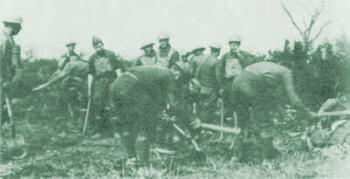 Divisional Engineers Build a RoadA Marine veteran of Blanc Mont would observe about his comrades in the Texas and Oklahoma National Guard years later:
German resistance stiffened at the road and the 142nd, now badly disorganized, formed a line composed of provisional organizations. From the right, near where the 141st would have been had it kept up, and from the front, the 142nd was subjected to a galling, enfilade machine gun fire. While the American artillery failed "to register on the enemy positions from which the heaviest fire was coming," the German artillery was on target. There appears to have been no threat to the left flank because it was covered by the marines at St. Etienne and by the French 7th Division west of town. At 4:30 P.M. several battalions of the German 14th Reserve and 195th Infantry Divisions commenced preparations for a counterattack from the northeast for the purpose of "encircling the right flank." In this situation, with ammunition, food, and water running low, the 142nd pulled back. According to Chastaine, some of the troops objected to giving up "hard earned ground" without a fight, but retreat was the only sensible course. With machine guns and automatic rifles covering the retirement, the 142nd"swung back" in a crescent-shaped line and halted with the left "at the village" and the right on Hill 160. A number of Doughboys who did not get the word for "the change in front" were left behind and captured. On the northern slope of Hill 160 provisional organizations of the 142nd established a line of defense, and utilizing German machine guns and ammunition captured earlier, repulsed the counterattack with relative ease… With nightfall approaching the fighting subsided and neither side attempted to make further headway. [General] Lejeune told Whitworth "to endeavor to reorganize his line," to establish liaison between the units, and to prepare for counterattacks. At Whitworth's request Lejeune ordered the relieved battalions of the 3rd and 4th Brigades to reoccupy the jump-off line. The situation was not as desperate as the generals were afraid it might be, but the precaution of bringing up the relieved troops was appropriate. October 9thThe 71st Brigade spent the night of October 8-9 attempting to reorganize its line and moving up food, water, and ammunition…The marines on the left and the 3rd Brigade troops on the right were nearly all relieved by the 2nd Engineers. "Off and on through the entire night," Chastaine reported, "the pup-pupping of the Maxims [machine guns] sounded at intervals" and occasionally "the bullets . . . would skirt the top of a parapet." Both sides kept up a harassing artillery fire and the Germans prevented the recovery of wounded men, whose cries could be heard between the lines, and hampered the efforts of Doughboy patrols seeking to locate and/or verify positions by constantly lighting the area with flares… German Prisoners Being Fed After the BattleErnst Otto, a German lieutenant colonel who served at Blanc Mont in 1916 and later wrote a book about the action there from October 2 to October 10, 1918, considers the attack of the 71st as unsuccessful and cites as his reasons, directly or indirectly, the heavy casualties, the poor execution, the use of faulty tactics, the perceived demoralization of the troops, and the inability of the brigade to continue on October 9. The success of the Germans in thwarting the drive of the Americans and the French on the flanks bought them time to prepare for an orderly retreat to the Aisne. The withdrawal, which began late on October 9, was not local; rather, it was a general retirement all along the front west of the Argonne Forest. [Ed. Note: Otto's book has been criticized as overly defensive of the German performance and hyper-critical of the American. Nevertheless, it's an informative work.] Pursuit: October 10th - 27th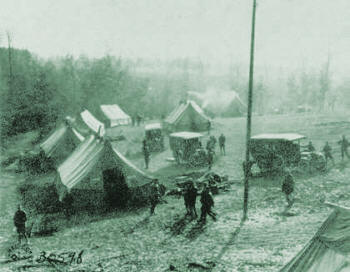 The 36th Division Deployed Near the River AisneBetween 5 and 6 p.m., the 72nd Brigade (143rd and 144th Infantry Regiments) passed through the 71st and attacked in the direction of Machault and Cauroy. The attack resulted in a slight advance. The following morning, the enemy began his retreat to the north in the direction of Dricourt and Attigny. The 72nd Brigade took up pursuit and lively rear guard actions followed between St. Etienne and Machault, which resulted in the encircling of the latter town and the establishment of lines to the north of it. The following day, the brigade pushed forward to Hill 167 northwest of Vaux Champagne, overlooking the valley of the Aisne from Attigny to Givry, from which positions patrols were pushed out t the canal. The enemy was strongly entrenched on the northern bank of the Aisne and had taken every precaution to prevent a crossing. The 71st Brigade went into line on the 13th, taking over the front of the 73rd French Division to the east of the 72nd Brigade. The division's line at this time ran along the slope of Hill 167 approximately four kilometers from the Aisne. No further attempts to advance were made until the 27th when the strong Forest Farm was stormed and taken by the 71st Brigade, the entire garrison being either killed or captured. The relief of the Thirty-Sixth began on October 28. The division was then assembled in the Suippes-Somme-Suippes area and from this point moved to the Triaucourt area and established headquarters at Conde-en-Barrois. Here it remained until the signing of the Armistice, as a unit of the First American Army. In the Meuse-Argonne (Champagne) operation, losses totaling 2,513 were suffered. |
|
Sources and thanks: The first contributor for this article was Leatherneck Ed Racely who gave me the photos of the Blanc Mont Ridge today and a Marine Corps Gazette article from March 1922 on the battle which was quoted extensively in the section on planning the battle. Scott Schoner of The Digital Bookshelf was tremendously helpful with photos from Colonel Otto's book and by making the Second Division Official History available to me. The later work formed the basis of the operational discussion of Phase I. Also, extremely helpful was Gary Butler of the Texas Military Forces Museum. He has asked that the following individuals and organizations be thanked for their works which served as the basis of the Phase II operational discussion. These include: The National Archives, BG Jay A. Matthews, publisher, Military History Associates, Inc., and The Texas Military Forces Museum located at Camp Mabry, Austin, Texas. Mr. Lonnie White's history PANTHERS TO ARROWHEADS: THE 36TH TEXAS-OKLAHOMA DIVISION IN WORLD WAR I Presidial Press [1984], available in its entirety at this link, has a full chapter on the Division's role in the battle which was made available for me exclusively for this article. Excerpts from this work may not be used for any other purpose, including retransmission in any form to any person or storage/archival medium, without obtaining written permission from the copyright holder, BG Jay A. Matthews (Military History Associates, Inc.), Austin, Texas. Fair use applies. MH |
To find other Doughboy Features visit our |
Membership Information  Click on Icon |
For further information on the events of 1914-1918
visit the homepage of |
Michael E. Hanlon (medwardh@hotmail.com) regarding content,
or toMike Iavarone (mikei01@execpc.com) regarding form and function.
Original artwork & copy; © 1998-2000, The Great War Society

